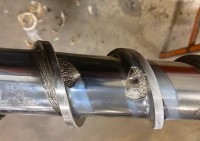
High-Performance Molding Starts with the Barrel and Screw
In today’s world of plastics processing, there is a significant focus on machine drive technologies, automation, smart manufacturing capabilities. All of which are very important when it comes to maintaining a competitive edge.
However, we should never lose sight of the fundamentals required for a productive and reliable plastics process.
The Center of the Universe
At the center of every injection molding, blow-molding and extrusion process, there is a barrel and screw. The right screw and barrel combination can make the difference between mediocre performance and high-profit productivity.
Off The Shelf vs Tailor Made
The challenges for a custom injection molder, compared to a captive molder, are usually very different. A custom molder processes a wide range of polymers shot weights and cycle times.
Enter the General Purpose (GP) screw designed to be versatile when handling different materials and their respective processing requirements.
Unless specified otherwise, a standard injection molding machine will be equipped with a GP screw, and if sized correctly to suit the shot weight, cycle time and throughput, it should be adequate for the task at hand.
In the world of captive molding or specific industry segments, such as packaging, it is common to have a screw geometry designed particularly for the task. In packaging applications, where the norm is for short cycle times and high material throughput, mixing screws and barrier screws is usually employed.

Mixing screws are designed to improve melt homogenization, including color dispersion. Barrier screws are intended to control the melting process. Essentially the mixing screws and barrier screws generate more mechanical shear than GP screws.
There is more attention to degradation caused by too much mechanical shear and/or too long residence time for technical applications employing engineering materials. It is not uncommon to utilize low compression screws for engineering materials.
In addition to screw geometry, the barrel and screw materials will also significantly bear wear and tear, corrosion resistance, and avoiding material contamination such as Black specks in transparent material.
Implementing a Preventive Maintenance Program
While screw geometry and material execution are fundamental to your processing performance, do not underestimate the effects of wear and tear. Poor maintained, and worn equipment will result in inconsistent melt preparation, part weight variations and poor part quality.
Click the link below for information on implementing a preventive maintenance program.
Reiloy Westland Corporation: Processing Tips
Proper Start-Up & Shut Down Procedures Can Help Prevent Component Wear
Start-up and shut-down procedures are critical factors in preventing broken valve tips and screws during plastics processing. Moreover, if these procedures are not followed correctly, they can contribute to adhesive, abrasive and corrosive wear.
This picture is an example of abrasive wear on an injection molding screw. Component wear affects processing and profits through lower production rates, higher reject rates, and downtime.

Click the link below for valuable guidance on your start-up & shut-down procedures.
Reiloy USA Start-up and Shut Down
It is imperative to consult with your equipment supplier when buying equipment to ensure you are choosing the right barrel and screw for your applications.
If you already have existing equipment, consult a screw and barrel manufacturer with the engineering expertise to precisely define your process’s right set-up. Reiloy USA will work with you to evaluate your processing needs to recommend the best screw and barrel design for your particular application.
Reiloy offers some excellent guides in specifying and maintaining your barrels and screws, such as the 11th Edition Handbook.
